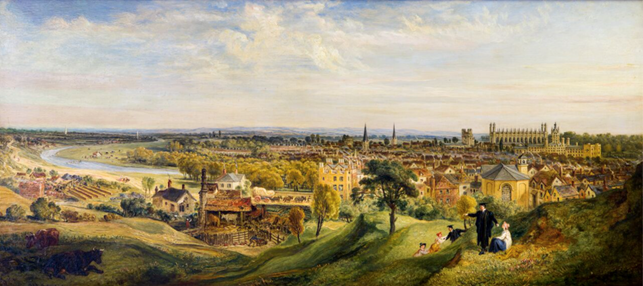Oil painting by James Ward, View of Cambridge from Castle Hill
By Dr N. Henry
John Le Keux (a London engraver) and James Ward (a London painter) both produced artistic impressions of the town of Cambridge viewed from Castle Hill around the same year, 1840. Whilst James Ward’s painting clearly depicts the town as foremost a university town, Le Keux’s engraving, based on a drawing by Mackenzie (London artist), seems, at first glance, to present a more down to earth version of Cambridge with the very foreground filled with cows and sheep rather than young scholars in academic dresses. The three figures on the left of the engraving could be visitors or town people.
The distribution of light and dark tones on the engraving however clearly leads the eye to the far distant group of university buildings, King’s College chapel clearly becoming the focal point of the picture whilst the ordinary dwellings are drowned in dark ink. Le Keux’s engraving is the portrait of a town in two halves: the dark heavy ordinary dwellings versus the light and airy university buildings.

This division, not surprisingly, reflects the division that existed at the time between town and gown and the animosity that often ensued. The engraving was produced as one of the many illustrations for the two volumes of the Memorials of Cambridge, a history of Cambridge published in collaboration with two Cambridge academics, Wright of Trinity College and Longueville Jones of Magdalene College. The volumes mostly depict university colleges with only the last few pages of the second volume offering a handful of selected street views. Thomas Wright’s appraisal of the town is rather stark:
The town of Cambridge, without the colleges, contains few remains of ancient buildings. There are several curious old houses, particularly in Bridge Street, Trinity Street, and the neighbourhood of the Petty Cury. The town generally is ill-built, and crowded with narrow inconvenient streets. The population, including the university, is 20,917. (Memorials of Cambridge, vol 2, p. 15)
Whilst gownsmen and townsmen were fighting in the streets of Cambridge with glass bottles, water, stones, pokers and all kinds of weapons (see the diary of Josiah Chater, E. Porter, pp. 30-31), academics seemed to have used the power of writing to assert the superiority of gown over town with general statements qualifying the town as “ill-built”, “crowded” and made of “inconvenient streets”. Nothing surprising here perhaps.
Whose town is it? In the nineteenth century the question generated intense emotions on both sides, town and gown, and probably remains unresolved today as the brand name “Cambridge” is very much protected by the university although this is merely the name of a small town that started as a large Celtic village on Castle Hill in the first century BC. The village expanded during Anglo-Saxon times (from the 8th century) and received its name from the small wooden bridge that once crossed the Cam where the Magdalene Bridge is now (see S Boyd p. 16). The first college, Peterhouse, was not founded until the year 1284.
So, whose town is it? Cambridge is essentially a small (expanding) town (city) on the Cam, the river having been, once, the beating heart of this human settlement.
References:
Enid Porter, Victorian Cambridge: Josiah Chater’s Diaries, Phillimore and Co, 1975
Stephanie Boyd, The Story of Cambridge, Cambridge University Press, 2005
Le Keux’s Memorials of Cambridge, London, 1841
